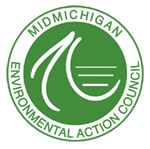A Letter From MidMichigan Environmental Action Council
The Lansing community is having an important conversation about energy. What will usage be in the next five-ten-20 years? What role can energy waste reduction have in shaping our needs? Why not just go 100% renewable, already?
That last question is on the lips of a number of residents. At recent public meetings, citizens and representatives of Sierra Club (SC), Lansing Environmental Action Team (LEAT), and MidMichigan Environmental Action Council (MidMEAC) asked Lansing City Council members and Lansing Board of Water & Light (LBWL) Commissioners to reduce our reliance on fossil fuels in favor of renewable energy sources.
LBWL Commissioners recently approved a plan to build a new compressed natural gas (CNG) power plant. This will allow the utility to close its last two coal-fired plants, Eckert in 2020 and Erickson in 2025, removing old emissions-scrubber technology from our local energy equation.
Trading coal for natural gas left some renewable energy advocates believing their voices had not been heard by the municipally-owned LBWL.
So, why not 100% renewable?
“LBWL cannot meet federal reliability standards with renewable energy alone,” said George Stojic, LBWL planning and development chief. Cascading blackouts in August 2003 affected 45 million people in eight U.S. states including Michigan, prompting Congress to define energy reliability standards.
We live in an “on demand” energy-usage landscape. Solar and wind are considered intermittent sources in the federal standards that also require a conventional energy source to meet peak-load generation.
Solar and wind are and will be a growing part of the mosaic of energy sources used locally, regionally, and globally. It is also likely that oil and natural gas will remain in use for the foreseeable future.
What can we do?
We have every reason to be optimistic about the future of renewable energy. Technologies including battery storage capacity will improve. Costs to transition to wind and solar energy generation are likely to decrease.
We can each of us do something to speed the transition:
- Take advantage of LBWL’s energy waste reduction programs for homes and businesses, including rebates for adopting efficiencies. Consumers Energy has a similar program.
- Use smart metering capabilities to reduce your energy usage during peak demand times.
- Lease a solar panel in LBWL’s community solar grid. Encourage others to invest in community solar arrays.
- Retrofit or build new small-scale renewable energy systems that supply energy locally and contribute to the larger grid (Distributed Energy Resource Systems or DERS.)
- Support a carbon tax with income-based offsets to address currently uncounted costs, like environmental remediation arising from mining, fracking, and pipeline activities, or infrastructure investment to compensate for increasingly volatile weather.
- Remain engaged in the energy conversation.
LBWL Commissioners have said that one of the two turbines planned for the new plant could be repurposed as an eventual replacement for the turbine at the REO Town plant. This would be made possible partly by our personal efforts to reduce energy waste and invest in community solar.
LBWL leaders have committed to regularly revisiting the community’s energy plan as efficiencies improve and new technologies make renewables more affordable and reliable. Let’s hold them to that promise.
We at MidMEAC can respect the real constraints of reliability standards in the current energy landscape, while also encouraging actions today that increase the renewables percentage in our local energy mosaic. We look forward to future conversations that move Lansing forward to 100% renewable energy.
